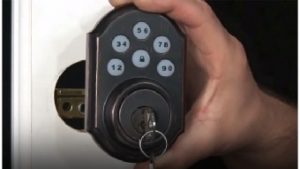
A significant number of security dealers have recognized the value of selling and installing smart electronic locks. There are not only revenue opportunities from the locks themselves, but potential RMR from the additional devices and service that the locks can generate.
There are some dealers who are reticent about making the change to smart locks due to the perceived difficulty of installation; however, the fact is, smart locks are exceedingly easy for a professional to connect. If you have installed a traditional deadbolt, installing a smart lock should be a piece of cake.
Perhaps it stems from getting those dreaded “some assembly required” toys and games when we were kids (or as parents) that contained hundreds of tiny pieces and a 30-page instruction manual, but for whatever reason, when we hear about a technological innovation – such as a smart lock – we assume (or have been told) that the installation will be a frustrating process. Installers assume they will have to drill a hole in a door or chisel out a frame, or perform some complicated electrical work. This actually could not be further from the case.
If you are replacing a traditional mechanical deadbolt with a smart lock, the hole you need for the smart lock already exists, the door is already chiseled, and the frame is already cut out. In fact, installing a smart lock is as easy as swapping in a new deadbolt. If the door is brand new, it should already have a pre-cut hole in place. The hole for the mechanical deadbolt works just as well for a smart lock, and in some cases, the smart lock might be a better fit. Today’s smart locks increasingly feature smaller footprints and tapered parts to help ensure that everything fits and the door closes correctly.
If the door does not fit after installing a smart lock, odds are that there are issues with the door frame or jamb – not the lock. To address this potential issue, before the old/original deadbolt is removed, the technician should ensure the bolt is free to move and does not bind up or have issues closing freely. It is important to address issues with the door frame or warping before the electronic deadbolt is installed. When it comes to complicated electrical work or wiring, there is none. Smart locks are battery operated and it is easy to pop in a few batteries.
Dealers do not want technicians spending hours at one location fiddling around with a high-tech gadget. Many dealers think they have to allocate hours for a smart lock installation, but the reality is that the installation takes a lot less time. This is especially true if the smart lock features one-touch programming.
“It should take 30 minutes or less to complete the smart lock installation – about 12 minutes to swap out the door lock; then somewhere between 5 and 15 minutes to upload the lock into the home automation platform, depending what the back-end looks like,” explains John Orth, a technician at Guardian Protection Services. “The majority of the install is actually download time, not install time. Once you have put in a few smart locks, it becomes second nature. If you take longer than a half hour, you are doing something wrong.”
The role of the smart lock in increasing smart home sales makes sense. Together with a central hub, the smart lock is a natural entry point for customers to enter the smart home arena – ironically because it is most often located at the entry to a home. Customers welcome the concept of controlling their home automation devices and scenarios from the convenience of their front door.
Getting past the false perception that installing smart locks is difficult means security dealers can truly open the door to enhanced customer retention, growth and profit.
According to a July 2017 Consumer Technology Association study, “Consumer enthusiasm for both emerging technology and resilient mature categories is exceeding expectations – driving the U.S. consumer technology industry to an estimated 3.2 percent revenue growth in 2017.” The study goes on to say that sales in the smart home category, including smart locks, will reach 27 million units in 2017 – a 50-percent increase over 2016.
Making a smart lock central to a home automation system makes sense in terms of customer retention and increased business. Home automation is still a fairly new concept to most homeowners – they have to build up their comfort level with the technology over time. This comfort level can only grow as customers are coming and going through the front door throughout the day, every day, and engaging with the smart lock and home automation.
The more customers use the smart lock to enhance convenience and security in their lives, the more likely they are to want to expand their system capabilities. When customers upgrade from a basic security system to a security system with home automation and a smart lock, the home automation system usually requires a higher level of service. This means dealers can offer and charge for a premium service package.











